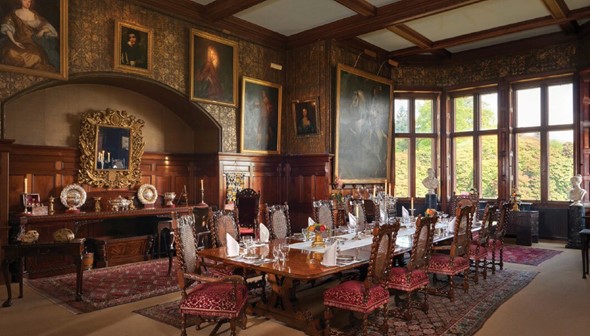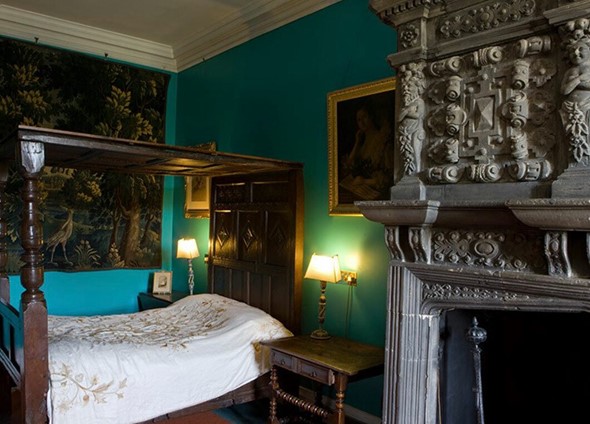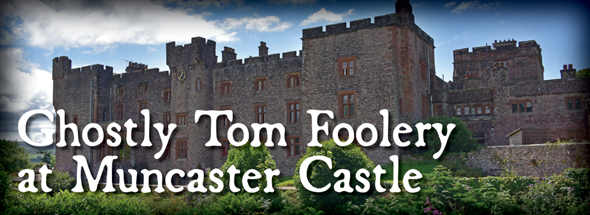Ghostly Tom Foolery at Muncaster Castle
By James Martin
Rising out of the stunning landscape of Cumbria, in the North West of England, Muncaster Castle stands as a formidable and ancient stronghold with a history dating back to Roman times. Despite its grandeur and beauty, the Castle has become synonymous with tales of ghostly encounters and unexplained phenomena. Over the years, Muncaster Castle has earned a reputation as one of England’s most haunted locations, captivating the minds of paranormal investigators and historians alike.
The name “Muncaster” probably derives from the Old Norse personal name ‘Múli’ alongside the Old English term for a Roman Fort, ‘cæster.’ It is suspected that the site of today’s Castle lies on Roman foundations whilst archaeology is ongoing; if true, the foundations may reveal a ‘castellum’ or watchtower overlooking the nearby Roman fort of Glannoventa at Ravenglass – the birthplace of St Patrick.
The Muncaster estate was granted to Alan de Penitone (Pennington) in 1208 and contains a Great Hall and a 14th-century ‘pele’ tower – a unique form of watchtower found on the English-Scottish border region. Muncaster Castle is still owned by the Pennington family, who have resided at Muncaster for at least 800 years as their family seat.

Throughout my childhood, Muncaster sometimes felt like a second home, with regular visits to the Castle and growing up with the many local tales of paranormal phenomena. Before you even arrive, many stories of the main road (the A595) approaching the Castle will have your hair on end. One of the most famous spectres at Muncaster Castle is the ‘Muncaster Boggle’ (boggle means apparition) or ‘White Lady.’ According to local folklore, she is believed to be the spirit of Mary Bragg, a housekeeper from Ravenglass. The story goes that she supposedly fell in love with one of the footmen at the Castle. Unfortunately for her, however, so was one of the housemaids. Her romantic attachment to the footman grew, and on one particular night, she was approached at home by two men who advised her that her lover was ill and he was calling her to his bedside.
Mary Bragg’s mother would ultimately be the last person to see her alive. Mary told her mum that the men were taking her to his bedside; alas, Mary’s body was found some weeks later, floating in the nearby River Esk. It was hardly recognizable because of the horrendous injuries. Eels had partially eaten the body, and the coroner could not tell how she died. The coroners’ report of 18 Nov 1805 hinted at suicide but was inconclusive. For two centuries, visitors and staff members have reported that the ghost of Mary Bragg can often be seen wandering the grounds of the Castle and along the local roads – it was believed that her murder occurred at the castle gates. Mary’s ghost is primarily dressed in white, though her form varies. She has been seen as a misty figure or a solid form, jumping out in front of cars before vanishing. Local lumberjacks believe she committed suicide, noting that a tree where Mary is said to have met with her untimely death on the castle grounds bled with blood when cutting it down.
Perhaps the room inside the Castle in which hauntings often occur is the Tapestry Room. Visitors complain of disturbed nights, hear footsteps in the corridors outside, and see the door handle turning and the door opening, although nobody is there. Perhaps the saddest – and most witnessed ghost – is a crying child whose sobs can still be heard in the room. It is believed to be the spirit of Margaret Pennington, who died aged 11 from ‘screaming fits.’
Another well-known apparition is that of “Tom Fool,” or Tom the Fool. Tom Skelton was a jester at the Castle in the late 16th and early 17th centuries. He is said to have been responsible for a large number of deaths. He loitered under a chestnut tree outside the Castle, directing travelers looking for Ravenglass down a path to the quicksands near the town rather than the road. He is also supposed to have beheaded a local carpenter under the instructions of Sir Ferdinand Pennington. The carpenter had been the lover of Sir Ferdinand’s daughter Helwise. The blood trophy was delivered to Sir Ferdinand, and the thuds of the body being dragged down the stairs can still be heard. Skelton’s portrait still hangs in the Castle. One visitor looking at the portrait said she heard footsteps on stone flooring behind her. When she turned, there was no one there. It was later pointed out to her that the stairs and corridor were, in fact, fully carpeted. It’s believed that the expression “Tom Fool” and “tomfoolery” originated with Thomas Skelton. The current owners of the Castle believe Tom still resides there, and they attribute most of the strange happenings to him, especially the more sinister activities.
Aside from these prominent phantoms, Muncaster Castle boasts a myriad of other ghostly tales too numerous to go into. Many treasures are present at the cast, such as the so-called “Luck of Muncaster,” a gift to the family from Henry VI who, following his defeat at the Battle of Hexham in 1464, was found wandering on Muncaster Fell and was brought to the Castle for shelter.

In gratitude, the king presented his hosts with a gilded glass drinking bowl, promising that as long as it remained unbroken, the Pennington’s would stay at Muncaster. The cup or “luck” remains undamaged within, and the Pennington family has retained possession of its Castle for over eight centuries.
Over the years, numerous paranormal investigations have taken place at Muncaster Castle. Teams of experts equipped with state-of-the-art technology have ventured into its darkened corners, seeking evidence of the supernatural. Their findings have added weight to the Castle’s reputation as a hotspot for paranormal activity, attracting thrill-seekers and ghost hunters worldwide. Despite the tales of ghostly encounters, the current inhabitants of Muncaster Castle, the Pennington family, take pride in preserving its history and folklore. They have embraced the Castle’s haunted reputation and frequently host ghost tours, sharing the chilling stories passed down through generations. As with all haunted locations, skepticism persists, and some may attribute the sightings to natural phenomena or overactive imaginations. However, the vast number of credible witnesses and the sheer volume of historical accounts lend an air of legitimacy to the haunting stories of Muncaster Castle. Muncaster Castle is a testament to England’s haunted heritage, captivating all who dare to explore its enigmatic past.
James Martin
James Martin is an author and lecturer and is often seen as the Official Historian Friday Nights on NightVision.





 KGRA Digital Broadcasting
KGRA Digital Broadcasting KGRA Digital Broadcasting
KGRA Digital Broadcasting